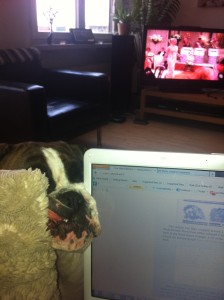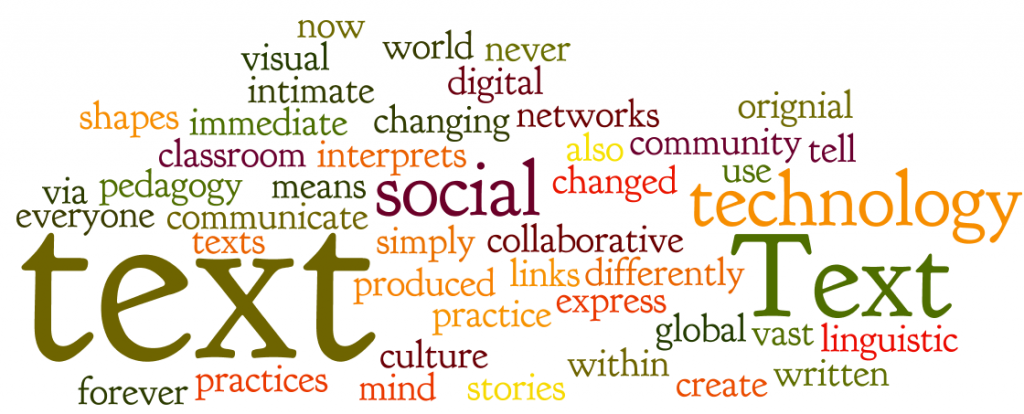When we first began this course, I was uncertain. It seems that is a natural progression throughout the MET program; each course is a new adventure. Looking back on the readings and assignments we have completed, it is impressive how much we have learned. My most embarrassing moment was very early on, googling ‘codex’ as I had no idea what we were talking about.
Ong was a challenge for me to understand and apply to my own life and teaching practice, but Bolter presented ideas that have an instant impact. The concept of remediation immediately made sense, and I now look at daily life and education through this lens. There is tension between text and visuals, and we can see the impact in the ways media has changed. Take a look at how newspapers are beginning to look – how they are changing to become more visually appealing and more like a site. We are watching text and communication change so quickly, due to rapid technology growth and change, and it is hard to predict where we will be next. We rely heavily on images and graphics, and we need to ensure that our students are prepared with the tools to decipher text and visuals.
There is concern for the repercussions of such an evolution of text. We hear concerns about youth losing the ability to write and read cursive, spell effectively, and create full sentences and paragraphs without texting lingo and emoticons. These are certainly elements that need to be considered, but I think there is a balance to be struck. Yes, there is a sense of loss when we look back with fondness at sending handwritten letters, but we must consider the gains made in global communication and efficiency.
Last week I was having a discussion with an elementary teacher about the concern that youth are losing the ability to write formally. We see texting lingo creep into typed stories constantly. Within his class, he has seen these shortcuts creep into handwritten work too. This fascinates me, because I can understand how fingers on a keyboard connect naturally to texting language, but when it leaps off the keyboard and into the physical act of printing and cursive writing, we are seeing a true change in the way people are thinking. For example, whenever I type the name Albert on my computer, I can’t stop myself from automatically typing Alberta. But when I handwrite it never happens. It is so connected to the keyboard in my mind that it stays there. We are now seeing a generation where it is infiltrating all areas of writing.
Instead of being concerned with what we are losing, we need to begin thinking about how we can meet the communication needs of our current and future society. If we teach our students how to read and write informal text, visual text, and formal text, they will be prepared for anything and everything that comes their way.
What I appreciated most about our coursework was how it was structured in such a way that we could find those areas that we truly connected with, in both the research topics and the tools we used to present our ideas. I am leaving this course with so many ideas to incorporate into my classes – starting first with digital storytelling and graphic novels.
How about you?




Storytelling with Web 2.0 Tools: A New Genre?
The Beginning
“Web 2.0 storytelling: the emergence of a new genre” by Alexander and Levine begins provocatively. In the past, according to the authors, stories had “a beginning, a middle, and a cleanly wrapped up ending” (p. 40) and were told, in one-way exchanges, by a storyteller or story tellers to a passive audience. “Or at least that’s what a story used to be, and that’s how a story used to be told” (p. 40). Such an extreme oversimplification of stories and storytelling throughout history immediately puts me on edge. The authors continue “Stories are now open-ended, branching, hyper-linked, cross-media, participatory, exploratory, and unpredictable.” (p. 40). With the exception of “cross-media”, these sound very much like the characteristics of oral storytelling, as we’ve learned from Ong (2002). In fact, most of these adjectives could be applied to some print stories as well. So the article begins badly, from my perspective, setting up a false foundation as a base of comparison from which to describe the changes to storytelling brought about by Web 2.0 tools.
Due to more user-friendly web publishing techniques, it is now very easy to create web content. To quote Cope and Kalantzis, “the practical business of doing multimodality is easy now, and because it is, we are using the affordances of the complementary modes to ease the semantic load that had been placed on written language” (p. 18). Alexander and Levine argue that ease of use and the affordances of Web 2.0 technology, such as collaboration and the findability of microcontent, have given birth to new practices for telling stories, and that these new practices constitute a new genre.
The Middle
The authors acknowledge that to “claim that there is now such a thing as ‘Web 2.0 storytelling’ invites risks” (p. 46). The risks, as they see them, are: 1) pinning down a moving target by giving it a name, and 2) asserting that storytelling is happening online contradicts a reported decline in reading. I see the latter as an explanation – there is a decline in book reading because more reading takes place online. The first risk is more valid. How can all the different forms and styles and even genres, of storytelling that use Web 2.0 tools be described as a genre unto themselves? (A mystery story told in a series of podcasts. A personal diary published on a blog, with comments from readers. A science fiction video posted on YouTube.) A genre is identified by shared conventions or style or form. I don’t see how these examples of Web 2.0 storytelling share any conventions or style or form.
However, their claim that Web 2.0 storytelling constitutes a new genre may be a red herring. Alexander and Levine write “we suggest there is most certainly a new form of expression that is compelling to educators” (p. 46). Although I would argue that there is not simply one new form of expression, there is a compelling and vast array of tools available to educators that offers possibilities to experiment with form, set up student collaborations, and mix and mash content from multiple media and genres. The authors describe a project they have been working on called 50+, in which they aim to discover more than fifty ways to tell the same story using Web 2.0 tools. With so many ways to tell a story, “aptness of mode” (Kress, 2005) takes centre stage: “the new media make it possible to use the mode of that seems most apt for the purposes of representation and communication” (Kress, 2005, p. 19). This is exciting for educators, and I think this idea is the strength of this article. The enthusiasm of the authors to experiment with Web 2.0 tools should encourage educators to consider “the facility of new media” (Kress, 2005) and incorporate them into their teaching, not for technology’s sake, but because they have a discovered a mode that is apt.
The Cleanly Wrapped Up Ending
A short piece on The New Yorker website this week called “On bad endings” talks about the many books, including classics such as War and Peace and Wuthering Heights, that start out great but end poorly. Columnist Joan Acocella says that it’s as if the authors, forced into the necessary step of closing out the narrative, have run out of energy and inspiration. She quotes E.M. Forster, who said in “Aspects of a Novel” that nearly every novel is a letdown: “This is because the plot requires to be wound up. Why is this necessary? Why is there not a convention which allows the novelist to stop as soon as he feels muddled or bored?” Indeed, why is there also not this convention for academic commentaries?
On a final note, since the publication of the Alexander and Levine article in 2008 there has been a retreat from the open space of the Web to the paid, closed, and proprietary spaces of apps (Anderson, 2010). Increasingly, people are using the Internet to download their favourite newspapers, magazines, movies, and music directly to their devices, bypassing the Web altogether. Has this trend away from the hyperlinked, flexible, and interactive silenced the buzz around Web 2.0, or are they parallel streams?
References
Acocella, J. (2012, November 27). On bad endings. The New Yorker. Retrieved from The New Yorker website http://www.newyorker.com
Alexander, B., & Levine, A. (2008, November/December). Web 2.0 storytelling: emergence of a new genre. Educause Review, p. 40-56.
Anderson, C., & Wolff, M. (2010, September). The Web is dead. Long live the Internet. Wired. Retrieved from the Wired magazine website http://www.wired.com/magazine
Cope, B., & Kalantzis, M. (2009). “ Multiliteracies ”: New Literacies , New Learning. Pedagogies: An International Journal, 14, 164–195. doi:10.1080/15544800903076044
Kress, G. (2005). Gains and losses: New forms of texts, knowledge, and learning. Computers and Composition, 22(1), 5–22. doi:10.1016/j.compcom.2004.12.004
Ong, W. (2002). Orality and literacy: technologizing the word. London: Routledge